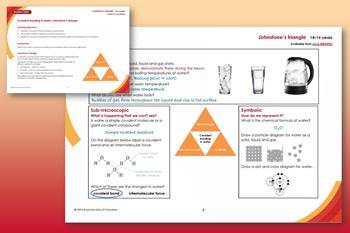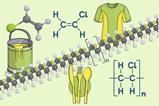Improve your students’ understanding of abstract ideas by explaining and linking the different levels of Johnstone’s triangle

Alex Johnstone developed a model based on a triangle to explain why chemistry can feel difficult, if not incomprehensible, to some students. He explained that if you communicate a theory on three different levels – and you link these together – you can help your students find an easier route to understanding a complex idea without unnecessary suffering.
Johnstone’s triangle
Macroscopic: phenomena that you can observe directly, e.g. identifying chemical changes in everyday life, such as cooking, rusting of metals, or combustion.
Submicroscopic: concepts that are too small to see, e.g. molecules, structures, geometry, polarity.
Symbolic: chemical symbols, formula/equations, diagrams, hazard warning symbols.
The three levels are:
- Macroscopic: phenomena that you can observe directly, e.g. identifying chemical changes in everyday life, such as cooking, rusting of metals, or combustion.
- Submicroscopic: concepts that are too small to see, e.g. molecules, structures, geometry, polarity
- Symbolic: chemical symbols, formula/equations, diagrams, hazard warning symbols.
While teachers might see chemistry on these three levels, novice learners cannot and they quickly become overloaded. Johnstone’s triangle links these levels. You can use the model as a teaching aid to check students understand what they are being taught and when planning lessons to ensure you’re not asking too much of learners.
Break the triangle down
Building and developing learners’ domain knowledge is vital to them eventually communicating using all three levels of the triangle. If students are not able to link all three levels, their understanding of concepts may be superficial. Repeatedly building and reinforcing links between the levels is better than working between all three at once.
Break it down
Building and developing learners’ domain knowledge is vital to them eventually communicating using all three levels of the triangle. If students are not able to link all three levels, their understanding of concepts may be superficial. Repeatedly building and reinforcing links between the levels is better than working between all three at once.

Separating the macroscopic, submicroscopic and symbolic out then linking them together may help improve long-term understanding. For example, the levels in the reaction between bromine solution and hex-1-ene are:
- Macroscopic bromine solution is quickly decolourised in hex-1-ene.
- Submicroscopic bromine molecules add across the double bond of hex-1-ene to form a colourless product (1,2-dibromohexane).
- Symbolic Br2 + C6H12 → C6H12Br2
When initially teaching a topic, it’s important to incorporate just two levels at a time to ensure ideas and concepts are securely embedded. Once the students get to grips with these, you can introduce the third level.
Dual coding can help make the triangle evident for students. Presenting information in two forms, one being visual (a diagram or image), can help to explain bonding related to properties for example, without overloading the working memory. This uses two of the three levels.
Simulations are also a useful tool. Students can start by drawing their explanations of what’s happening and then follow this up with a computer simulation. This is a great way to use two levels of the triangle and really understand what students think is happening at the submicroscopic level to explain what they see at the macro level. In a practical there’s a lot for students to take on board, so using microscale and integrated instructions can really help with retention.
Drip-feeding any links to a third level is essential to ensure pupils are confident and their understanding is not superficial
The idea of dual coding can help make the triangle work in practice too. For example, presenting information in two forms, one being an image, can help explain bonding related to properties. This would involve using two of the three levels.
Simulations are also a useful tool. Students can start by drawing their explanations of what’s happening and then follow this up with a computer simulation, such as those from PhET (bit.ly/4cOO11d). This is a great way to use two levels of the triangle and really understand what students think is happening at the submicroscopic level to explain what they see at the macro level. In a practical there’s a lot for students to take on board, so using microscale (rsc.li/4cnzSZ5) and integrated instructions (rsc.li/4eO74u3) can really help with retention.
Drip-feeding any links to a third level is essential to ensure pupils are confident and their understanding is not superficial
The macro (observable) element is hopefully straightforward. You can provide the symbolic level with a completed balanced equation, which leaves, ‘what does this look like at the submicroscopic level?’
You can use multiple choice questions as a basis to check understanding and to facilitate discussions in class.
Example question
Explain what happens when you see (macroscopic) liquid water, H2O(l), changing to steam, H2O(g). Choose a description that explains the process and draw it (submicroscopic), then write the equation (symbolic).
- weak forces of attraction between the water molecules are broken.
- strong forces of attraction between the water molecules are broken.
- weak forces of attraction between atoms in the water molecules are broken.
- strong forces of attraction between atoms in the water molecules are broken.
Pupils can find moving between the three levels tricky and giving them the opportunity to match up the correct representations from each level is a key skill worth developing in small steps.
The macro (observable) element is hopefully straightforward. You can provide the symbolic level with a completed balanced equation, which leaves, ‘what does this look like at the submicroscopic level?’
Pupils can find moving between the three levels tricky and giving them the opportunity to match up the correct representations from each level is a key skill worth developing in small steps.
You can use multiple choice questions as a basis to check understanding and to facilitate discussions in class. Find an example on the Education in Chemistry website (rsc.li/4eHEJG1).
Adapt questions for different ages
There are opportunities for using the same question with different year groups. You can represent combustion, for example, symbolically in different ways. With lower stages you can emphasise the equations and state symbols, whereas at higher stages you can use the thermodynamic profiles to enhance communication of the process and introduce concepts such as enthalpy.
Level up
There are opportunities for using the same question with different year groups. You can represent combustion, for example, symbolically in different ways. With lower stages you can emphasise the equations and state symbols, whereas at higher stages you can use the thermodynamic profiles to enhance communication of the process and introduce concepts such as enthalpy.
Johnstone’s triangle can be a powerful aid in planning progression in your lessons. Using only two sides of the triangle when building up the domain knowledge and drip feeding any links to a third level over the long term is essential to ensure pupils are confident and their understanding is not superficial.
-

Browse our collection
Introduce Johnstone's triangle to your classroom with our resources on a growing range of topics. Learners complete a Johnstone's triangle for a specific chemistry example and then use this alongside questions designed to develop and connect their understanding in the macroscopic, submicroscopic and symbolic levels.
Browse our collection
Introduce Johnstone’s triangle to your classroom with our resources on a growing range of topics. Learners complete a Johnstone’s triangle for a specific chemistry example and then use this alongside questions designed to develop and connect their understanding in the macroscopic, submicroscopic and symbolic levels. Explore the resources on the Education in Chemistry website: rsc.li/XXXXXXX



















No comments yet